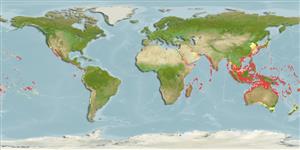Common names from other countries
Environment: milieu / climate zone / depth range / distribution range
Écologie
; profondeur 2 - 71 m (Ref. 101222). Tropical
Indo-Pacific.
Length at first maturity / Taille / Poids / Âge
Maturity: Lm ? range ? - ? cm Max length : 50.0 cm TL mâle / non sexé; (Ref. 822); common length : 12.0 cm BASL mâle / non sexé; (Ref. 349); poids max. publié: 500.00 g (Ref. 2594)
Common among seaweeds and grass flats in shallow water environments, especially in sheltered bays and lagoons (Ref. 349). Found during the day under rocks and at night crawling around reef flats and seagrass beds (Ref. 844). Inhabits eel grass beds, reef flats, or tidal swimming pools (Ref. 866). Nocturnal (Ref. 822).
Life cycle and mating behavior
Maturité | Reproduction | Frai | Œufs | Fécondité | Larves
Members of the order Anaspidea are mostly simultaneous hermaphrodites.
Poutiers, J.M. 1998. (Ref. 349)
Statut dans la liste rouge de l'IUCN (Ref. 130435)
statut CITES (Ref. 108899)
Not Evaluated
Not Evaluated
Menace pour l'homme
Harmless
Utilisations par l'homme
| FishSource |
Outils
Sources Internet
Estimates based on models
Preferred temperature
(Ref.
115969): 22.6 - 29.1, mean 28 (based on 1616 cells).
Résilience
Haut, temps minimum de doublement de population inférieur à 15 mois (K=0.8-1).
Vulnérabilité
Moderate vulnerability (40 of 100).
Catégorie de prix
Unknown.
